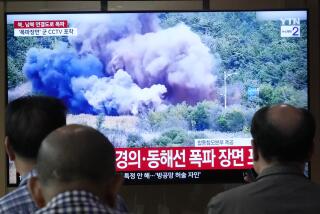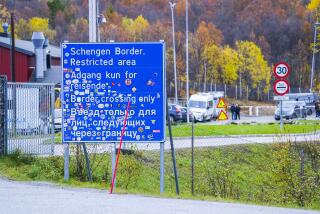Border Separating N. Korea From China Appears Too Porous to Seal : Asia: A trip along the Tumen River suggests just how difficult imposing economic sanctions on North would be.
- Share via
TUMEN, China — On the Chinese side of the border, a convoy of seven North Korean flatbed trucks, sagging under their load of several tons of Chinese rice, rumbled under an ornamental gate on their way across the Tumen River to North Korea.
Half a mile or so across the shallow, snow-fed river on a recent afternoon here, a North Korean steam engine whistled impatiently as it waited to receive the vital cargo and transport it to the hungry interior. North Korea is an economically strapped nation where food is strictly rationed and where the patriotic goal, still unrealized, is two meals a day for all citizens.
U.S. reporters granted a rare visit to the Chinese-North Korean border here in Jilin province recently watched a steady flow of such goods being transported between Tumen, one of seven border-crossing points in the province, and the North Korean town on the opposite bank.
Local officials said the trade has increased in recent months as the threat of U.N. economic sanctions against North Korea has mounted because of its suspected nuclear weapons program. The prospect of such sanctions seemed to recede over the weekend after former President Jimmy Carter’s visit. But if they ever materialize, North Korea would rely even more heavily on its main link to the outside--the corridor of northeast China along the Tumen River where North Korea, China and Russia meet.
More than 40% of North Korea’s $736 million in trade with China--its main lifeline for grains, other food and fuel--passes through this remote area that is home to most of China’s ethnic Korean population.
For any U.N. sanctions to succeed, this border would have to be sealed. But those who know the area say that would be a difficult, if not impossible, task for several reasons:
* Security along the 312-mile border in Jilin province is minimal, and smuggling is rampant. Few expect the Chinese government to vigorously enforce sanctions even if they are approved by the United Nations.
* Since 1982, when the border reopened after a 12-year break in friendly relations between the two countries sparked by China’s Cultural Revolution, trade with North Korea has become one of the most important factors in the local economy.
Sun Jinhu, deputy director of foreign trade for the Yanbian Autonomous Prefecture here, said the biggest increase in cross-border trade has come in the past two years--a jump from $80 million in 1991 to more than $300 million last year. About 22 North Korean companies operate small joint-venture businesses, mostly hotels and restaurants, on the Chinese side.
* Ethnic and language ties among Koreans on both sides of the border are likely to subvert any attempt to implement sanctions meant to punish North Korea for its nuclear stance.
Korean Chinese rallied in great numbers to fight alongside their cross-border neighbors and relatives during the Korean War against American-led U.N. forces. Monuments to local soldiers killed in the conflict line both banks of the Tumen River. The nearly 1 million Korean Chinese who live in the Tumen River valley would probably resist any foreign efforts to close the border.
“More than 40% of our population is ethnic Korean,” Sun said. “They share the same habits, language and lifestyle with the people across the border in the Democratic People’s Republic of Korea (North Korea).”
In Yanji, the major city of the Korean Chinese ethnic minority area, waitresses in joint-venture restaurants wear lapel buttons bearing a photograph of North Korean leader Kim Il Sung. Korean singers in slinky gowns at the Bai Shan Nightclub croon North Korean ballads. The many stalls at the West Market in downtown Yanji sell North Korean products, ranging from red fox pelts to the gray stone pots and griddles highly prized in the Korean community.
If the sanctions proposal ever does come to a vote before the U.N. Security Council, the Chinese government is expected to abstain. But even if the sanctions were approved, their success would depend upon Chinese enforcement along this border. And there is no evidence here of a Chinese willingness or even ability to take this step.
From 1970 to 1982, the Chinese government officially closed its border with North Korea, both because of the 1966-76 Cultural Revolution and because North Korea had taken the Soviet side in the Sino-Soviet split.
But even then the closing had little effect on the Korean population. When the political persecution of the Cultural Revolution became too intense, Koreans simply crossed over to the “motherland” to wait out the storm. When the Tumen River froze, as it does each winter, families walked across, as they have for centuries, to visit relatives on the other side.
Today, with relations repaired, the Tumen River is not so much a border as it is an inconvenience. Despite the severity of the North Korean regime, the border is one of the least secured in the world.
“We have a (312-mile) border with North Korea,” said Chao Zhizhong, vice general manager of the Yanbian Foreign Economic Trade Co., which does $27 million in business annually with the North Koreans. “We have a long history of relationships and trade along the Tumen River. People come and go freely.”
The government recently announced a crackdown on smuggling along the border. But there was little evidence of any new precautions during a recent visit.
In a two-hour drive along the river between Yanji, capital of the Yanbian Korean Autonomous Prefecture, and the Russian border, the only evidence of border security was at lightly manned border-crossing stations and a few scattered watchtowers.
The most lasting impression from the trip was the huge gap in prosperity between the Chinese and their North Korean neighbors. Compared with the Chinese side of the border, undergoing a development boom sparked by the drive to develop the lower stretch of the Tumen River as a port linking China to the Sea of Japan, Korean villages on the other bank of the river looked shabby and silent.
Traffic was heavy along broad new stretches of highway on the Chinese side, including hundreds of expensive imported four-wheel-drive trucks. But except for a pair of aging steam engines and the decrepit convoy of trucks on the Tumen bridge, there was no sign of motorized transport on the North Korean side.
In their arguments against sanctions, Chinese officials here argue that what North Korea needs most is not isolation but more exposure to the emerging market economy of its huge neighbor and former comrade in arms.
North Korea is particularly sensitive about its dependence on China for the most basic commodities.
At the Tumen border station, photographers have erected colorful backdrops featuring Chinese and North Korean flags so that visitors can be photographed with North Korea in the background. But when American reporters began photographing the rice-laden trucks, a North Korean official appealed vainly to Chinese officials to confiscate the film.
Trade Gateway
China is the main route for goods into North Korea. More than $300 million worth of goods passes through the remote corridor of northeast China along the Tumen River near where North Korea, China and Russia meet.
More to Read
Sign up for Essential California
The most important California stories and recommendations in your inbox every morning.
You may occasionally receive promotional content from the Los Angeles Times.












